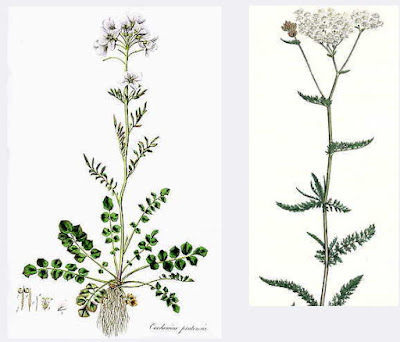William Curtis (1746-1799) is one of a number of botanical artists and engravers I much admire.
These plates are from William Curtis' classic Flora Londinensis : Or plates and Descriptions of Such Plants as Grow Wild in the Environs of London: With their Places of Growth, and Times of Flowering; Their Several Names according to Linnaeus and Other Authors.
A brilliant and indefatigable botanist, Curtis, at the age of 26, was appointed Praefectus Horti and Demonstrator to the Society of Apothecaries at the Physic Garden in Chelsea. Chiefly interested in British flora, Curtis set out to record and describe all the plants growing within a ten-mile radius of London.
In 1777, Curtis brought out the first volume of the Flora Londinesis, of which some 300 copies were printed. When the sixth and final volume came out, the work contained descriptions of 435 species, illustrated on 432 hand-coloured engraved plates. Curtis was forced to abandon his project when it proved financially disastrous. Patrons were simply not interested in the unassuming flora of southern England. In 1787, Curtis turned his attention to the Botanical Magazine and the illustration of exotic foreign species.
Although Flora Londinensis was not a financial success, the work contains some the largest and most spectacular plates in the history of English botanical art. The full-page engravings were prepared from drawings by William Kilburn, James Sowerby, and Sydenham Edwards, all of whom went on to achieve artistic fame. The majority of the figures, according to Salisbury, "represent the most successful portrayals of British wild flowers that have ever been achieved". The copper-plate engravings were printed on fine water marked, chain-linked paper and hand-colored at the time of publication.









.jpg)





















































The mind boggles at the magnitude of that task.
ReplyDeleteAmazing! And so sad that it never became the success it should have been. You know, sometimes I wonder, what would have become of the authors, painters, composers, architects, craftsmen etc. of the past, had they had the same technological possibilities as we do now, such as blogging and making their art and craft known to a global audience.
ReplyDeleteThis is a good read....I have always enjoyed these engravings.
ReplyDeleteI suppose there is a balance, Librarian, between ther technological advances which might have made their works so much better known and the fact that they would have had to 'compete' with photogrphic illustrations as modern artists do when recording exactly what they see in front of them as opposed to creating something from their imasgination.
ReplyDelete